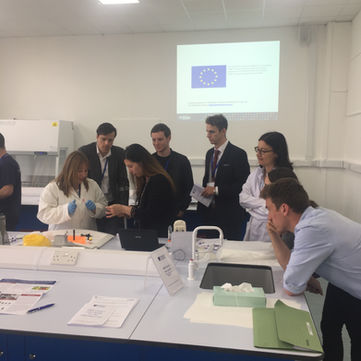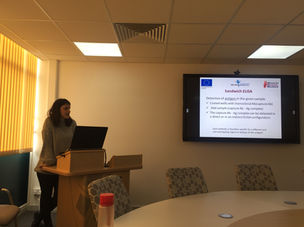PROGRAMME OVERVIEW
Clinical research on the mechanisms involved requires a multidisciplinary approach covering aspects of ageing, metabolism, and on the humoral cross-talk of muscle with other key organs including the heart, liver, kidneys, and lungs. To achieve this, six European groups with complementary expertise in inter-organ-cross-talk during stress-induced secondary myopathies will team-up with three leading teams in the U.S. with expertise in myopathy animal models, myofilament proteins and translation of muscle research into therapeutic interventions, and with one team from South Africa with cutting-edge expertise in the regulation of regenerative capacities in muscle.
Importantly, five SMEs will participate in this RISE network that provide expertise in early muscle disease detection, monitoring, and the developing preventive strategies: Their knowledge on muscle disease detection at early stages and their monitoring during interventions will promote translational innovation. To implement innovation and our joint research program, both early stage and advanced researchers will be seconded from the academic nine teams to these five SMEs and vice versa. Thereby, this RISE scheme will establish a long-term collaborative University-SME driven translational innovative research program innovation in our interdisciplinary field of growing socioeconomic medical importance.
SCIENTIFIC OBJECTIVES
1. Understand the crosstalk between skeletal muscle & other organ systems in disease.
2.� Identify potential biomarkers (including autoantibodies) in mammalian models for detecting early loss of muscle function.
3. Develop diagnostic procedures for detecting muscle pathology (mass and function).
4. Test biomarker validity in local or European studies OR set the basis for follow-up work.
INNOVATION & TRAINING OBJECTIVES
The overall goal of this programme was to support intersectoral cooperation and interdisciplinary training on muscle pathophysiology with a view to medical translation for therapeutic muscle stress relief and improved diagnostics.
This enabled our network participants to recognize and materialize market opportunities when apparent during our research. More specifically:
1. Create an environment of trust for true intersectoral exchange of ideas and interests.
2. Provide formal and informal learning opportunities and develop skills for a globalized and knowledge based economy – via workshops & seminars for the new generation of muscle researchers.
3.Support exchange of good practices between countries and sectors – through employing task-tailored knowledge sharing methodology and frequent interactions.
4. Enhance creativity and innovation, including entrepreneurship, to set the basis for long- term partnerships.
OUR APPROACH
•Nine academic and five SME beneficiaries, with four TC academic partners carried out an integrated intersectoral & international research program.
•MUSCLE STRESS RELIEF was implemented through seven (7) workpackages (WPs), of which six (6) mainly supported the scientific objectives, including research training of ESRs, while one (1) supported the research administration and consortium-wide research networking activities.
WORKPROJECTS & OBJECTIVES
NERVE & MUSCLE
Labeit (UHEI), UF, SU, TND, Myomedix
[Vumc, ZI, EMBL]
1.1: Determine remodeling of the neuromuscular junction (NMJ) in muscle stress states. In vivo confocal LM
1.2: Follow coordinated remodeling within myofibers and in NMJ In vivo by confocal light microscopy in living mice.

REGULATION OF MUSCLE CATABOLISM
Sandri (VIMM), UF, SU, TND, DLD, Myomedix, BME
[Genethon]
2.1: Determine how autophagosomes are activated in muscle stress states.
2.2: Attempt therapeutic autophagosome inhibition in living mice.

KIDNEY & MUSCLE
Karatzaferi (UTH), MARJON, SU, UoC, TND, BME, DLD, KSL
[UoK]
3.1: Determine how kidney failure leads to skeletal atrophy and force loss.
3.2: Explore how kidney failure and cardiomyopathy are inter-related.

DIAPHRAGM & VENTILATION
Ottenheijm (VUmc), UF, UoA, DLD, Myomedix
+ BME for innovation training
4.1: Determine the key genes and mechanisms involved in diaphragm force loss during mechanical ventilation.
4.2: Determine rescue potential by knock-outs and knockdowns to preserve diaphragm force

BIOMARKERS OF MUSCLE STRESS
Mayans (UoK), UHEI, UF, TND, DLD, KSL
+ BME for innovation training
[UTH, Genethon, EMBL, ZI, Vumc]
5.1: Identify biomarkers in experimental muscle failure models.
5.2: Determine clinical relevance of titin autoantibodies Europe-wide
5.3: Test clinical relevance of serum titin for muscle stress disorders
5.4: Identify stress-related epitopes and raise specific antibodies to them for marketing and diagnostics.

THERAPEUTIC RELIEVE FROM MUSCLE STRESS
Richard (GENETHON), SU, UF, UoA, Myomedix, KSL
+TND for innovation training
[UoK, UTH, UHEI]
6.1: Identify critical molecular and structural domains in stress signaling.
6.2: Test viral therapeutic gene delivery strategies.
6.3: Test small molecules for muscle stress relief.

MANAGEMENT, ADMINISTRATION AND NETWORKING
Karatzaferi (UTH), MARJON, UF, SU, UoC, BME, TND, DLD, KSL, Myomedix
[VIMM, UHEI, VUmc]
7.1: Establish a Muscle Stress Relief Office dedicated network admin.
7.2: Annual retreat of PIs in Athens.
7.3: Biannual retreat of ESRs, muscle summer school.

PUBLISHED WORK BY OUR FACULTY IN THIS PROJECT
June 2019
EFFECTS OF REDOX DISTURBANCES ON MOTILITY, CONTRACTILITY AND MUSCLE TISSUE PATHOGENESIS
April 2019
EVIDENCE OF BLOOD AND MUSCLE REDOX STATUS IMBALANCE IN EXPERIMENTALLY INDUCED RENAL INSUFFICIENCY IN A RABBIT MODEL
January 2019
EVIDENCE OF FUNCTIONAL DEFICITS AT THE SINGLE MUSCLE FIBER LEVEL IN EXPERIMENTALLY-INDUCED RENAL INSUFFICIENCY
December 2017
MODULATORS OF ACTIN-MYOSIN DISSOCIATION: BASIS FOR MUSCLE TYPE FUNCTIONAL DIFFERENCES DURING FATIGUE
March 2017
FUNCTIONAL RESPONSES OF UREMIC SINGLE SKELETAL MUSCLE FIBERS TO REDOX IMBALANCES
January 2016
SKELETAL MUSCLE ATROPHY: DISEASE-INDUCED MECHANISMS MAY MASK DISUSE ATROPHY


























